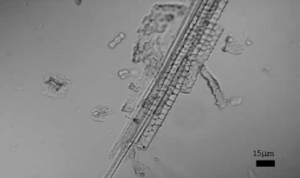 Plants absorb and transport silicon from soil. The precipitation of silicon within the living plants results in biosilica structures known as phytoliths (plantstones). During phytolith mineralization, a small amount of C (<2%) can become trapped and therefore protected from environment degradation. Since different plant types exhibit distinctive phytolith morphologies, their concentrates are used in identifying vegetation histories or food culture adaptations, as well as absolute chronologies when its “carbon occluded” is directly dated by 14C.
Plants absorb and transport silicon from soil. The precipitation of silicon within the living plants results in biosilica structures known as phytoliths (plantstones). During phytolith mineralization, a small amount of C (<2%) can become trapped and therefore protected from environment degradation. Since different plant types exhibit distinctive phytolith morphologies, their concentrates are used in identifying vegetation histories or food culture adaptations, as well as absolute chronologies when its “carbon occluded” is directly dated by 14C.
Since photosynthesis is the major mechanism in which green plants acquire C to synthesize their own food, it is assumed that the C trapped in phytoliths should reflect the atmospheric CO2 isotopic values at the time the plant was growing. However, this assumption has been recently challenged by 14C data from phytoliths extracted from living grasses that yielded ages of several thousand years (Santos et al. 2010 Radiocarbon 52(1): 113-128).
Because plants take up small amounts of C of varying ages from soils (e.g. during nutrient acquisition), the “unexpected” 14C values from phytoliths extracted from living grasses lead to the hypothesis that this transported C once within the plant tissue could become attached or even trapped in the biosilica.
 The recent interest in sequestering atmospheric C by promoting cultivars capable of producing large amounts of phytoliths makes it essential to evaluate the origin of C embedded in phytoliths (regardless of the functionality of such approach): if phytoliths are merely “recycling” C from soil, their potential for biosequestration is minimal (Biogeosciences Discuss., 9, 329–356, 2012 www.biogeosciences-discuss.net/9/329/2012/ doi:10.5194/bgd-9-329-2012)
The recent interest in sequestering atmospheric C by promoting cultivars capable of producing large amounts of phytoliths makes it essential to evaluate the origin of C embedded in phytoliths (regardless of the functionality of such approach): if phytoliths are merely “recycling” C from soil, their potential for biosequestration is minimal (Biogeosciences Discuss., 9, 329–356, 2012 www.biogeosciences-discuss.net/9/329/2012/ doi:10.5194/bgd-9-329-2012)
Dr. Santos and her colleagues use isotope analyses of phytoliths extracted from high silicon accumulator grasses that were exposed to distinct C isotope labels. She and her team are also re-evaluating phytoliths extraction protocols and their associated biosilica purity levels.
Dr. Santos has close interactions with researchers from the Departments of Earth System Science and Ecology and Evolutionary Biology at UCI, as well as the Stable Isotope laboratory team in CEREGE/France and the Soils and Sediments Analysis Laboratory, University of Wisconsin-Madison.
This project is funded by the National Science Foundation under Grant Number (award 1144888).
Disclaimer: “Any opinions, findings, and conclusions or recommendations expressed in this material are those of the author(s) and do not necessarily reflect the views of the National Science Foundation.”